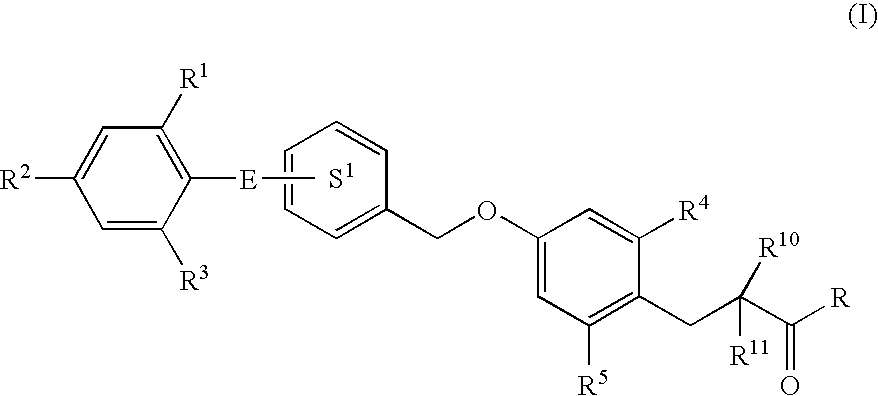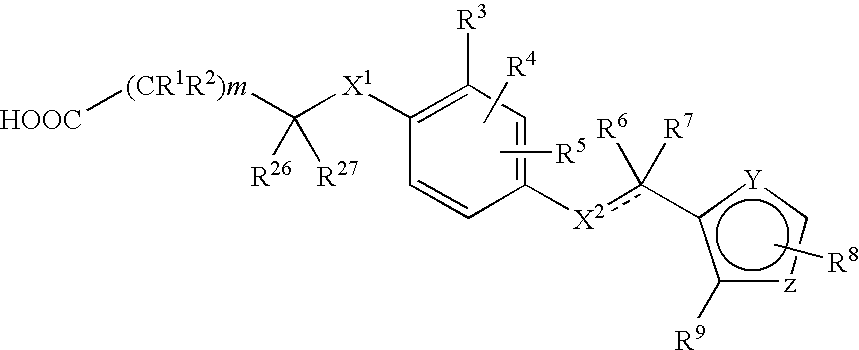3-(4-benzyloxyphenyl) propanoic acid derivatives
a propanoic acid and derivative technology, applied in the field of new compounds, to achieve the effect of superior gpr40 receptor function modifying action
- Summary
- Abstract
- Description
- Claims
- Application Information
AI Technical Summary
Problems solved by technology
Method used
Image
Examples
reference example 1
2-(4-bromo-3-methylphenoxy)tetrahydro-2H-pyran
[0454]
[0455]A solution of 4-bromo-3-methylphenol (4.72 g, 25.2 mmol), 3,4-dihydro-2H-pyran (3.18 g, 37.8 mmol) and pyridinium p-toluenesulfonate (0.628 g, 2.50 mmol) in dichloromethane (100 mL) was stirred at room temperature for 24 hrs. The reaction mixture was washed with water, and dried over anhydrous sodium sulfate. The solvent was evaporated under reduced pressure to give the title compound (7.11 g, including unreacted 3,4-dihydro-2H-pyran) as a yellow oil.
[0456]1H NMR (CDCl3) δ: 1.58-2.06(6H, m), 2.35(3H, s), 3.56-3.63(1H, m), 3.83-3.91(1H, m), 5.37(1H, t, J=3.1 Hz), 6.77(1H, dd, J=8.8, 3.0 Hz), 6.95(1H, d, J=3.0 Hz), 7.39(1H, d, j=8.8 Hz).
reference example 2
2′-methyl-4′-(tetrahydro-2H-pyran-2-yloxy)biphenyl-3-carbaldehyde
[0457]
[0458]2-(4-Bromo-3-methylphenoxy)tetrahydro-2H-pyran (7.11 g, 25.2 mmol, including 3,4-dihydro-2H-pyran) and (3-formylphenyl)boronic acid (4.50 g, 30.0 mmol) were dissolved in a mixture of 1 M aqueous sodium carbonate solution (60 mL), ethanol (30 mL) and toluene (60 mL), and after argon substitution, tetrakis(triphenylphosphine)palladium(0) (1.73 g, 1.50 mmol) was added. The reaction mixture was stirred under an argon atmosphere at 80° C. for 15 hrs. The reaction mixture was cooled, water and ethyl acetate were added, and insoluble material was filtered off through celite. The organic layer of the filtrate was washed with saturated brine, dried over anhydrous sodium sulfate and concentrated under reduced pressure. The residue was purified by silica gel column chromatography (5%-30% ethyl acetate / hexane) to give the title compound (6.16 g, yield 82%, 2 steps) as a pale-yellow oil.
[0459]1H NMR (CDCl3) δ: 1.53-1.77...
reference example 3
[2′-methyl-4′-(tetrahydro-2H-pyran-2-yloxy)biphenyl-3-yl]methanol
[0460]
[0461]2′-Methyl-4′-(tetrahydro-2H-pyran-2-yloxy)biphenyl-3-carbaldehyde (13.6 g, 45.9 mmol) was dissolved in a mixture of 1,2-dimethoxyethane (70 mL) and tetrahydrofuran (70 mL), and sodium borohydride (0.870 g, 23.0 mmol) was added under ice-cooling. The mixture was stirred at the same temperature for 3 hrs. To the reaction mixture was added aqueous ammonium chloride solution, and the mixture was extracted with ethyl acetate. The extract was washed with saturated brine, dried over anhydrous sodium sulfate and concentrated under reduced pressure. The residue was purified by silica gel column chromatography (15%-50% ethyl acetate / hexane) to give the title compound (12.2 g, yield 89%) as a colorless oil.
[0462]1H NMR (CDCl3) δ: 1.59-1.76(4H, m), 1.85-1.90(2H, m), 1.97-2.11(1H, m), 2.25(3H, s), 3.60-3.67(1H, m), 3.91-3.99(1H, m), 4.73(2H, d, J=5.8 Hz), 5.46(1H, t, J=3.1 Hz), 6.92-6.97(2H, m), 7.14(1H, d, J=8.1 Hz), 7...
PUM
| Property | Measurement | Unit |
|---|---|---|
| reaction time | aaaaa | aaaaa |
| reaction time | aaaaa | aaaaa |
| reaction temperature | aaaaa | aaaaa |
Abstract
Description
Claims
Application Information
 Login to View More
Login to View More - R&D
- Intellectual Property
- Life Sciences
- Materials
- Tech Scout
- Unparalleled Data Quality
- Higher Quality Content
- 60% Fewer Hallucinations
Browse by: Latest US Patents, China's latest patents, Technical Efficacy Thesaurus, Application Domain, Technology Topic, Popular Technical Reports.
© 2025 PatSnap. All rights reserved.Legal|Privacy policy|Modern Slavery Act Transparency Statement|Sitemap|About US| Contact US: help@patsnap.com



